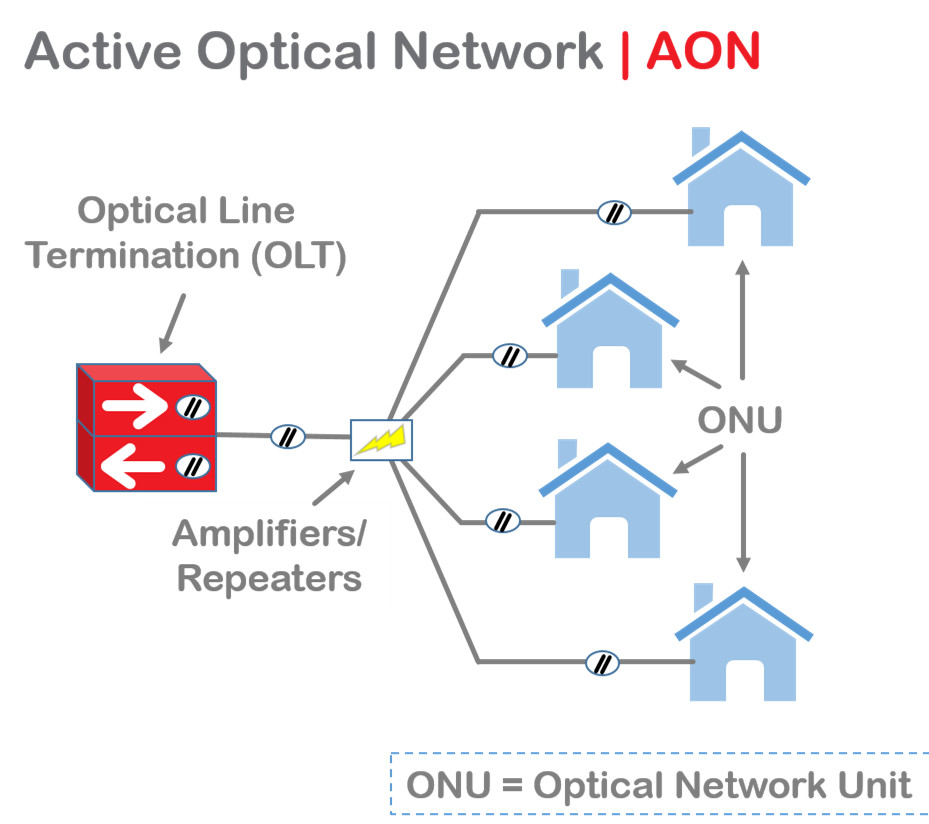/ From: / Review:1905
For operators rolling out FTTH, they have various network architecture options to consider. And the options can be classified into passive optical networks (PON) and active optical networks (AON). The PON requires no active electrical components between the end-user and the central office, while the AON has active electrical components installed between the end-user and the central office. The PON has three major point-to-multipoint variants: BPON (Broadband PON), GPON (Gigabit PON), and EPON (Ethernet PON). This post will have an overview of these different network architectures.
PON Basics
The PON architecture comprises an optical line terminal (OLT), based in the central office, and the optical networking terminal (ONT), sometimes referred to as an optical network unit (ONU), based on the customer premise. To connect the OLT and ONT with data, a fiber optic cable is used to carry a wavelength downstream. By using a passive splitter, the downstream data originating from OLT can be distributed. A series of passive splitters may have to be located within the PON architecture to reach the required number of customers. This is a point-to-multipoint architecture, sometimes described as a tree.

The upstream data running from the ONT to OLT, which is delivered on a separate wavelength to avoid collisions with the downstream transmission, is aggregated by the same passive splitter unit, which also carries out the recombining function. This enables data to be collected by the OLT over the same single fiber that sends the traffic downstream.
PON Variants
Based on expensive ATM (asynchronous transfer mode) interfaces and comparatively low throughput speeds, BPON is now arguably the least attractive of the three main PON options. So this part will introduce GPON and EPON respectively.
GPON
The GPON standard is the most recent PON variant to emerge. This standard works exceeded initial expectations. It can deliver downstream speeds of up to 2.48 Mbps, which can be shared to 64 customers. The higher subscriber capacity makes GPON easy to scale. Apart from its faster speeds and greater subscriber capacity, the most significant extra functionality that GPON offers is its ability to support multi-protocols in their native format. The GPON standard can support Ethernet, TDM and ATM. Operators using the GPON can therefore continue to offer legacy services, such as TDM-based voice and leased lines, without having to change customer’s premise equipment.
|
Data throughput capacity |
GPON customers share downstream speeds of up to 1.24 Mbps or 2.48 Mbps; the shared upstream speed is up to 622 Mbps or 1.24 Gbps |
|
Subscriber capacity |
Supports 32 users per tree at a recommended maximum distance between the OLT and ONT of 20 km. If serving 64 users (the maximum GPON subscriber capacity) the distance between the OLT and ONT is reduced to 12-15 km if maximum throughput is to be maintained. If the number of users drops to 16, the distance between the OLT and the ONT can extend to 30 km |
|
Protocol supported |
ATM, Ethernet, TDM |
EPON
Using a point-to-multipoint architecture in the same way as GPON, EPON operators can take advantage of the maturity and prevalence of the Ethernet standard and its associated economies of scale. How far these economies of scale actually extend is a matter of some dispute. According to IDATE, a research and consulting firm, EPON-based ONTs are one to two times less expensive than their GPON counterpart. The GPON vendor argues that the typical low price of an EPON ONT can be attributed to a comparatively short reach of 10 km and a requirement for data only. By contrast, the GPON ONT is specified at 20 km and often includes voice and support for RF video. If an EPON ONT and a GPON ONT were configured identically, there would be little difference in cost to produce either unit.
|
Data throughput capacity |
1.25Gbps on the downstream, 1.25Gbps on the upstream |
|
Subscriber capacity |
Supports up to 32 users per tree with a recommended maximum distance between the OLT and ONT of 20 km |
|
Protocol supported |
Ethernet only |
AON Basics
An active optical network comprises an active Ethernet switch that acts as the intermediate point between the central office and the end-user. Theoretically, this switch is capable of delivering symmetrical speeds of 100 Mbps to 32 users simultaneously. This level of throughput could only be achieved, however, if the link between the remote Ethernet switch and the central office supported 3.2 Gbps (32 x 100 Mbps). As this is expensive, AON detractors say it is more likely that the AON operator will use similar assumptions about bandwidth usage patterns as PON operators and oversubscribe the AON on similar lines. This would negate the AON bandwidth advantage.

By contrast, AON supporters say that one of the key advantages they have over a PON architecture is that it is much easier to remotely manage the network to guarantee bandwidth throughput to individual customers. That’s because an AON is intelligent and the PON is dumb.
Summary
Both PON and AON have their own features. Bursty capacity is the key characteristic of point-to-multipoint PON, which allows operators to allocate extra shares of the downstream bandwidth to users when they need it. AON has greater bandwidth scalability and higher symmetrical bandwidth capability, but it also needs higher costs to maintain a multitude of remote active Ethernet switches.